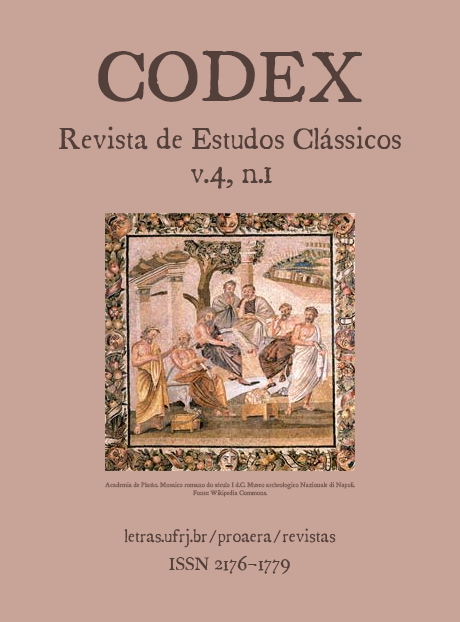What is so ‘classical' about Classical Reception? Theories, Methodologies and Future Prospects
DOI:
https://doi.org/10.25187/codex.v4i1.3339Keywords:
classical reception, Electra, Cacoyannis, AngelopoulosAbstract
This paper delivered at the University of Rio on 3rd June 2015 seeks to explore different approaches to the most fundamental questions in classical reception studies. What is classical reception? And more particularly what is so ‘classical' about classical reception? It discusses current trends in theory and methodology via an analysis of two cinematic receptions of the ancient story of Electra; one that proclaims its debt to a classical text while the other masks its classical connections.References
BAKOGIANNI, A. Electra Ancient & Modern: Aspects of the Reception of the Tragic Heroine. London: Institute of Classical Studies, 2011.
BAKOGIANNI, A. “The Taming of a Tragic Heroine: Electra in Eighteenth-Century Art”. In: International Journal of the Classical Tradition 16.1 (March), 2009, pp. 19-57.
CACOYANNIS, M. “Discussion: Ancient Drama and the Film”. In: Symposium International á Delphes 18-22 Août 1981, le Théâtre Antique de nos Jours. Athens: Centre Culturel Européen de Delphes Athènes, 1984, pp. 211-28.
GADAMER, H-G. Truth and Method. New York: Continuum, 1960, 2. ed. 1965.
HALL, E. “Towards a Theory of Performance Reception”. In: HALL, E. and HARROP, S. (eds.) Theorising Performance: Greek Drama, Cultural History and Critical Practice. London: Duckworth, 2010, pp. 10-28.
HARDWICK, L. “From the Classical Tradition to Reception Studies”, In: Reception Studies, Greece & Rome, New Surveys in the Classics no. 33. Oxford: Oxford University Press, 2003, pp. 1-11. . “Fuzzy Connections: Classical Texts and Modern Poetry in
English”, In: PARKER, J. and MATHEWS, T. (eds.). Tradition, Translation, Trauma: The Classic and the Modern. Oxford: Oxford University Press, 2011, pp 39-60.
HARDWICK, L. and STRAY, C. “Introduction: Making Connections”. In: A Companion to Classical Receptions. Malden, MA and Oxford: Blackwell Publishing, 2008, pp. 1-9.
HORNBLOWER, S. and SPAWFORTH, A. (eds.) The Oxford Classical Dictionary. Oxford: Oxford University Press, 2012, 4. ed., pp. 1256-57.
ISER, W. The Act of Reading: A Theory of Aesthetic Response. Baltimore and London: The Johns Hopkins University Press, 1978.
JAUSS, H. R. Towards an Aesthetic of Reception. Trans. T. Bahti. Minneapolis, WI: University of Minnesota Press, 1982.
KAHANE, A. “Methodological Approaches to Greek Tragedy”, In: ROISMAN, H. (ed.) The Encyclopedia of Greek Tragedy. Oxford and Malden, MA: Wiley- Blackwell, 2014, pp. 839-49.
KURTZ, D. “An Introduction to the Reception of Classical Art”. In: KURTZ, D. (ed), Reception of Classical Art: An Introduction, Studies in Classical Archaeology III. Oxford: Oxford University Press, 2004, pp. 31-45.
MARTINDALE, C. Redeeming the Text: Latin Poetry and the Hermeneutics of Reception. Cambridge: Cambridge University Press, 1993.
. “Introduction: Thinking Through Reception”, In: MARTINDALE, C. and THOMAS, R. F. (eds.). Classics and the Uses of Reception, 2006, pp. 1-13. “Reception – a New Humanism? Receptivity, Pedagogy, the Transhistorical”. Classical Receptions Journal 5.2, 2013, pp. 169-83.
MCDONALD, M. “A New Hope: Film as a Teaching Tool for Classics”, In: HARDWICK, L. and STRAY, C. (eds.). A Companion to Classical Receptions. Oxford and Malden. MA: Blackwell Publishing, 2008, pp. 327-41.
MICHELAKIS, P. Greek Tragedy on Screen. Oxford: Oxford University Press, 2013.
PAUL, J. “Working with Film: Theories and Methodologies”, In: HARDWICK, L. and STRAY, C. (eds). A Companion to Classical Receptions. Malden. MA and Oxford: Blackwell Publishing, 2008, pp. 303-14.
PORTER, J. I. “Reception Studies: Future Prospects”, In: HARDWICK, L. and STRAY, C. (eds). A Companion to Classical Receptions. Malden, MA, and Oxford: Blackwell Publishing, 2008, pp. 469-81.
Downloads
Published
How to Cite
Issue
Section
License
Copyright (c) 2016 Anastasia Bakogianni

This work is licensed under a Creative Commons Attribution-NonCommercial 4.0 International License.
This work is licensed under a Creative Commons Attribution-NonCommercial 4.0 International License.










